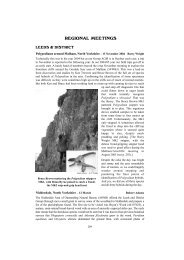Full Contents as pdf File - Natural History Museum
Full Contents as pdf File - Natural History Museum
Full Contents as pdf File - Natural History Museum
You also want an ePaper? Increase the reach of your titles
YUMPU automatically turns print PDFs into web optimized ePapers that Google loves.
LYNTON, DEVON – 12-14 September A.R. Busby<br />
Some twenty-eight members <strong>as</strong>sembled at the Bridge Inn, Lynton on the Friday evening to<br />
be briefed on the weekend’s meeting by the leader, Paul Ripley. He circulated a handout<br />
providing details of the sites to be visited. We were fortunate to be blessed with the most<br />
gorgeous September weather although the fern growers amongst us were agreeing how<br />
desperate we were for some rain.<br />
Saturday came and our first port of call w<strong>as</strong> at Ashcombe, Simonsbath at 21/774394.<br />
Close to the car park were the public conveniences, which gave us our first glimpse of<br />
the ferns in the area. On the walls we found Asplenium trichomanes, A. ruta-muraria,<br />
A. scolopendrium, Polypodium vulgare and a couple of small plants of Cystopteris<br />
fragilis. More hart’s tongue w<strong>as</strong> found along the small brook that ran through the car<br />
park.<br />
We made our way alongside the brook and quickly found large are<strong>as</strong> of bracken,<br />
Pteridium aquilinum. It w<strong>as</strong> also ple<strong>as</strong>ing to see Polypodium vulgare growing <strong>as</strong> it<br />
should be seen, <strong>as</strong> an epiphyte on the branches of the trees. Throughout the woodland we<br />
found Dryopteris filix-m<strong>as</strong>, Athyrium filix-femina, Blechnum spicant, Dryopteris dilatata<br />
and D. affinis agg. D. affinis subsp. borreri w<strong>as</strong> quite abundant in this area, <strong>as</strong> it w<strong>as</strong><br />
throughout the area we visited over the weekend. This gave us the opportunity to discuss<br />
and examine its distinguishing features. Nick Hards concluded that D. affinis subsp.<br />
affinis w<strong>as</strong> also present at this site although it w<strong>as</strong> not seen at any other place we visited.<br />
In the more open are<strong>as</strong> we found Oreopteris limbosperma and a strong candidate for<br />
D. affinis subsp. cambrensis, a frond of which w<strong>as</strong> taken for further study. Polypodium<br />
vulgare w<strong>as</strong> also very evident and we quickly realised that both P. vulgare and<br />
P. interjectum were present. The consensus of opinion w<strong>as</strong> that P. vulgare tended to be<br />
on the trees (although it also occurred on walls) and P. interjectum w<strong>as</strong> mainly found on<br />
the walls.<br />
Retracing our steps to the car park, Paul led us on to another site close by the road some<br />
three-quarters of a mile away at Lime Combe (21/765394). Here we were shown a small<br />
but well grown plant of beech fern, Phegopteris connectilis. This w<strong>as</strong> a good find<br />
because it is not at all common in that area. During our ramble to this site we p<strong>as</strong>sed a<br />
low retaining wall thickly furnished with more Asplenium trichomanes with several<br />
A. adiantum-nigrum amongst it.<br />
Pteris cretica in Joan Loraine’s garden, Porlock<br />
111<br />
photo: J.M. Ide<br />
By now it w<strong>as</strong> midday and<br />
Paul’s excellent planning<br />
found us outside Boevey’s<br />
Restaurant so we were able<br />
to take lunch. Polypodium<br />
vulgare and P. interjectum<br />
were found growing<br />
together at one place on the<br />
surrounding walls, which<br />
gave a good opportunity to<br />
compare them.<br />
After lunch we made our way<br />
across moorland for what we<br />
considered to be the highlight<br />
of the weekend, a visit to<br />
Joan Loraine’s garden at

















